Share this Post

For parents, hearing your child struggle to get their words out can be challenging. Stuttering can impact a child’s confidence, social interactions, and willingness to speak. However, with the right support, patience, and communication strategies, you can help your child feel more comfortable expressing themselves.
At CST Academy, we understand that every child’s journey with stuttering is unique. Some children experience occasional disruptions in their speech, while others may have more persistent challenges. Regardless of the severity, the way parents and caregivers respond to stuttering can make a big difference in a child’s ability to communicate with confidence.
Here are five supportive and effective strategies to help improve communication with your child who stutters.
1. Create a Relaxed and Patient Environment
One of the most important things you can do for your child is to foster a calm and supportive space for communication. When children feel rushed or pressured, stuttering may become more noticeable. By creating a relaxed speaking environment, you encourage your child to express themselves without fear or frustration.
To promote a stress-free communication setting:
- Speak at a slow and relaxed pace when talking with your child.
- Pause before responding to give them time to process their thoughts.
- Maintain eye contact and show interest in what they are saying rather than how they are saying it.
- Avoid finishing their sentences or guessing words, as this can add unnecessary pressure.
By demonstrating patience and allowing your child to take their time, you help reduce tension and make communication more enjoyable for both of you.
2. Focus on What Your Child is Saying, Not How They Say It
Children who stutter may become self-conscious about their speech, especially if they sense frustration or concern from others. As a parent, your focus should be on the content of your child’s message rather than their fluency.
To build confidence in their speech:
- Acknowledge and respond to their ideas with enthusiasm and encouragement.
- Avoid interrupting or correcting their speech patterns.
- Reinforce the idea that their words and thoughts matter, regardless of how they are expressed.
By placing importance on what your child is communicating rather than how fluently they are speaking, you help them feel valued and heard.
3. Encourage Turn-Taking in Conversations
Children who stutter often feel more pressure in fast-paced conversations where they need to compete for speaking time. Encouraging structured turn-taking during conversations can reduce this pressure and help them feel more confident when speaking.
To foster turn-taking skills:
- Model taking turns in conversations by allowing each person in the family to have their moment to speak.
- Use activities like storytelling games, where everyone gets an opportunity to share without interruption.
- Show patience when your child speaks, letting them finish their thoughts before responding.
By creating a predictable speaking routine, your child can build confidence knowing they will have their turn to express themselves.
4. Use Positive Reinforcement and Avoid Criticism
Children who stutter may already feel frustrated with their speech, so it is important to provide positive reinforcement and avoid criticism. Encouragement helps them build self-confidence and continue working on their communication skills.
Ways to provide positive support:
- Praise their effort in communication rather than focusing on fluency.
- Use phrases like “I love hearing your ideas” instead of “Try saying that again smoothly.”
- Celebrate moments when they express themselves confidently, regardless of any stuttering.
- Avoid negative comments such as “Slow down” or “Think before you speak,” as these can increase pressure and anxiety.
Encouraging your child with positive affirmations helps them feel more comfortable expressing themselves without fear of judgment.
5. Seek Support from a Speech-Language Pathologist
If stuttering persists or begins to impact your child’s confidence and daily communication, seeking support from a speech-language pathologist (SLP) can be beneficial. A trained therapist can assess your child’s specific needs and develop strategies to help them improve their fluency in a supportive environment.
An SLP can provide:
- Techniques to help your child manage stuttering in different situations.
- Strategies for improving communication confidence.
- Parental guidance on how to best support speech development at home.
Professional guidance can be a valuable tool in helping children who stutter gain the skills they need to communicate more effectively.
Building Confidence and Encouraging Communication
Stuttering does not have to define your child’s communication experience. With patience, encouragement, and the right strategies, you can help your child build confidence in their speech. The key is to create a supportive environment where they feel heard, respected, and encouraged to express themselves freely.
At CST Academy, we believe that every child deserves the opportunity to communicate without fear. If you have concerns about your child’s speech development or want to explore therapy options, our team of specialists is here to help. Contact us today to learn more about how we can support your child’s communication journey.
Discover Our Pediatric Therapy & Autism Care
ABA Therapy
Support for children with autism.
Diagnostic Evaluation
Expert assessments to identify child needs.
Pediatric Therapy Services
Speech, Occupational, Feeding, and Physical Therapy.
Therapeutic Preschool & Kindergarten
A classroom environment designed for early learners with unique needs.

Find the Best Care for Your Child




